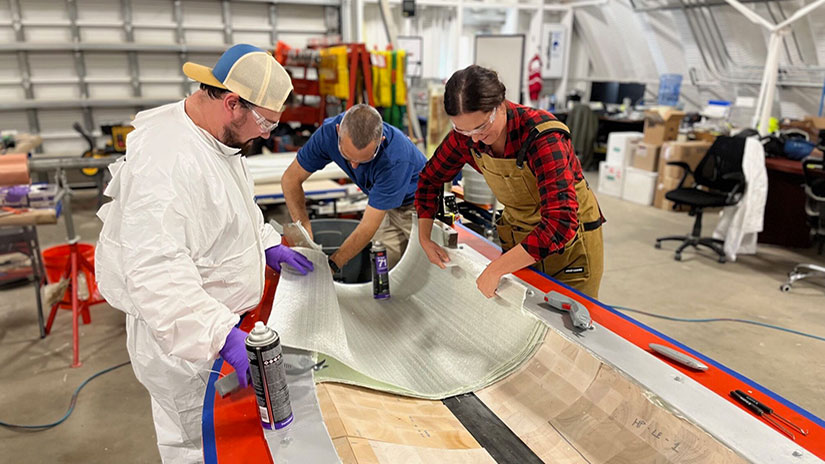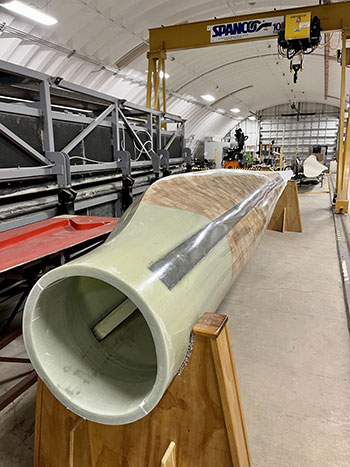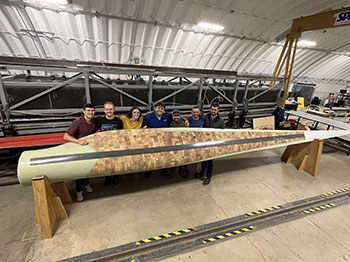Recyclable, Plant-Based Material Could Take a Spin on Next Generation of Wind Turbines
NREL Researchers Successfully Build a Wind Turbine Blade With Their Novel Resin
About three years ago, National Renewable Energy Laboratory (NREL) researchers Robynne Murray, Nicholas Rorrer, and their team set out on a mission to make an easily recycled resin to serve as the central glue holding a wind turbine blade together.
They began by formulating their resin in thimble-sized vials at the lab bench. And after several rounds of experimenting, fine tuning, and slowly scaling up, the team successfully used their new resin to construct a 9-meter prototype wind turbine blade (the size of a volleyball net)—marking a major milestone toward the material’s readiness for mainstream manufacturing.
Nicknamed PECAN, the new resin boasts a novel composition, but it is neither flavored nor made with its nutty namesake. Instead, the name is an acronym representing the material’s chemical structure (PolyEster Covalently Adaptable Network). The researchers designed the PECAN resin using biobased chemicals that can be easily extracted from plant waste.

Now, you may be thinking, “What’s the point of using plant waste to make a wind turbine blade?”
The answer lies in sustainability and recyclability.
More than 70,000 wind turbines are currently operating in the United States, and that number is expected to grow significantly as the nation accelerates toward a clean energy future. In fact, it is estimated that more than 2 million tons of wind turbine blade materials will be deployed in the United States by 2050.
Traditionally, most resins used in wind turbine blades require nonrenewable resources (like petroleum) and lots of energy to make. They are also difficult or impossible to recycle cost effectively and without significantly degrading the material.
To decarbonize the energy sector and eliminate waste, the wind energy industry needs a new, sustainable solution.
However, as it turns out, developing resins that are durable and easily recycled can be a tough nut to crack. But the NREL team is proving they are up for the challenge with the PECAN resin.
Sustainable From the Start

But PECAN-based wind turbine blades benefit from more than just green building blocks. The process to manufacture a blade with PECAN resin is greener, too.
The NREL team showed that the PECAN resin produces 40% less greenhouse gas emissions and requires 30% less energy to make when compared to the epoxy primarily used in today’s U.S. wind turbine blades.
“This is huge,” Murray said. “It creates the potential to save significant energy and money while also decarbonizing the first life of each turbine.”
Built To Last
No matter how sustainable a wind turbine blade is, the last thing it should be is flimsy. That is why the NREL team created the PECAN resin to exhibit the same—or, in some cases, better—structural performance compared to today’s wind turbine blade materials.
For example, the new material outperformed traditional resins in the “creep” department. Do not worry. Creep, in this instance, is not a measure of the number of spiders crawling on the blade. Rather, the term indicates how well a blade holds its stiffness over time.
“If a wind blade hangs out in the air under its own weight for long enough, you may see it start to lose its stiffness. And that could be a really big problem with other resin systems,” Murray said.
"And thanks to its unique chemistry," Murray continued, “we’ve been able to show the PECAN material performs really well on creep tests.”
But Readily Recyclable
Like just about anything, wind turbines do not last forever. And once they have reached the end of their operating life, recycling their components is an essential part of creating a sustainable wind energy industry.
The PECAN resin also hits the mark in the recyclability category. Manufacturers can depolymerize it (or break it down) using minimal energy or equipment and no harsh or nasty chemicals.
“This means blades made with the PECAN resin have the potential to be recycled at the wind farm decommission site, which can minimize blade transportation emissions and further decarbonize the life cycle of each turbine," Murray said.
Of course, this is not a coincidence. The NREL team carefully designed the resin to consist of a network of special chemical bonds (called ester linkages), which can be broken down with safe and affordable chemicals, contributing to the ease of recycling the material.
Made Possible in One-of-a-Kind Lab

“At NREL, we have everything from expert biopolymer scientists to state-of-the-art testing capabilities all in one place,” Murray said. “This has allowed us to streamline the whole research process, taking this resin from conceptual chemistry to an actual blade in just a few years, which is pretty unheard of!”
Next, the team plans to manufacture an even bigger blade with the PECAN resin, which will allow them to perform additional structural experiments before the resin is market ready.
If all goes well, the team is hopeful their resin can be an easy drop-in replacement for current wind turbine materials. And that is a solution the wind energy industry is sure to find appetizing.
Learn more about NREL’s novel wind turbine materials research, and check out the Manufacturing Mastermind Series to read the stories of the people behind this work.
Last Updated May 28, 2025
